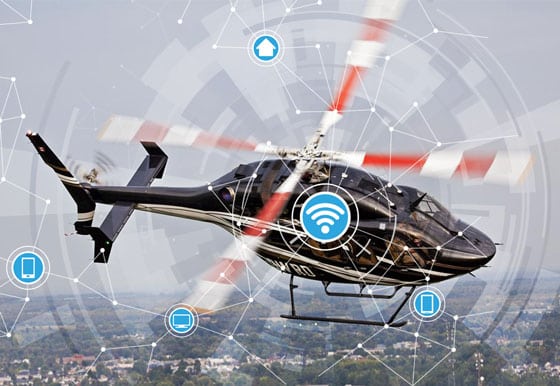Latest News

The C150 Global Odyssey’s Bell Helicopter 429, with Honeywell’s Aspire 200 satellite communications system and GoDirect Cabin Connectivity. Photo courtesy of Honeywell
The integration of newly available satellite and cellular-based data communications technologies, or “connectivity,” is creating new opportunities to improve helicopter offshore support, search and rescue (SAR), medevac and corporate/VIP operations. While the concept of the connected helicopter is not new (Iridium notes that 15,000 helicopters globally are equipped with products that enable its satellite communications service), operators are now realizing the benefits of speedy satellite and cellular LTE connectivity.
When contemplating a business case for investment in new satellite and cellular communications technologies, operators must seriously consider their mission sets. Is investment in new antennas, satcom configuration modules, onboard network routers and the service that enables the use of speedier data rates on board really worth it? Several operator investments and vendor certification announcements in 2017 have shown that the connected helicopter is a concept with great potential.
In July 2017, airborne cellular and satellite communications tracking systems provider Flightcell published a report profiling the use of its DZM3 satellite phone tracking and data system. Bristow Helicopters used the solution across its fleet of Sikorsky S-92s and Leonardo AW189s for the U.K.’s civilian SAR coastguard service. Bristow pilots use the technology for satellite phone calls in the cockpit and cabin. Winch operators and paramedics use mission management control touchscreens for thermal imaging and tactical mapping, enabled by the integration of Iridium transceivers into the aircraft voice and data communications systems — completed by DZM3.
California’s San Diego Police Department’s aviation unit also invested in connectivity this year. The unit’s fleet of Airbus Helicopters AS350 B3s are now equipped with AT&T LTE SIM cards. AT&T has also integrated the force’s core IT-based infrastructure network system with the LTE network, allowing access to information like addresses and street names during airborne missions.
With the upgrade, San Diego’s tactical flight officers are able to access the department’s computer-aided dispatch system, giving the team near-real-time information about evolving incidents. Its computer-aided dispatch tablet application, for example, allows the tactical flight officer to access the same information that ground units access. Before the LTE solution, this interoperability was not possible.
Connectivity can also be used to lower maintenance costs, proven by the partnership with Metro Aviation, PHI Inc. and Sikorsky…
Get the latest Via Satellite news!
Subscribe Now